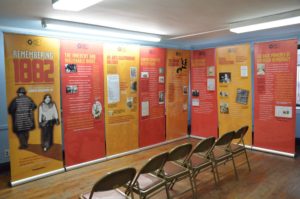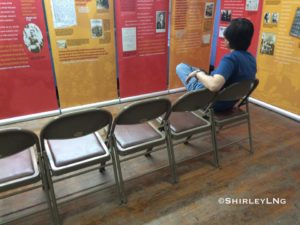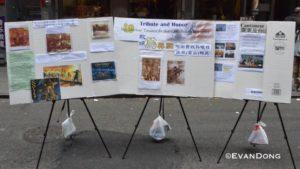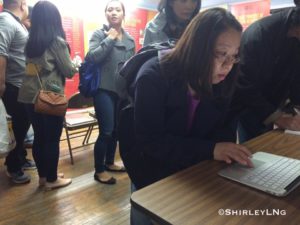By Shirley N Lew
AsAmNews New York Correspondent
In 1882, the Chinese Exclusion Act was passed by Congress and signed by President Chester Arthur. It denied the Chinese of their basic American civil rights solely because of their race. They were denied their right to become naturalized citizens, their right to vote and denied entry into the US. It was later renewed for an additional ten years in 1892 and eventually became permanent in 1902. The Chinese were the first ethnic group to be denied entry due to their race.

It was not till the Magnuson Act in 1943 repealed the law during World War II, when China became ally in the war against Japan.
How many of you are aware of the Chinese Exclusion Act?
Asian American history is not taught in the New York City public school system so this was a personal opportunity for photographer Corky Lee to do his part, to teach the younger generation about the discrimination and racism the Chinese had endured many years ago.
Lee rented the Chinese Exclusion Act traveling exhibit from the Chinese Historical Society Museum in San Francisco. It was his mission to educate as many as possible on Chinese American history and was able to hold an exhibit for the last two Sundays at the First Chinese Baptist Church on 21 Pell Street located in Manhattan’s Chinatown.

Prior to arriving in Chinatown, the exhibit was in Ogden, Utah with Lee. He had the exhibit shipped there during the 147th anniversary on the completion of the transcontinental railroad. He was there to recreate the famous photo of the completion of the railroad as he did last year. Unlike the original black and white photograph on the completion of the railroad in 1869 which featured no Chinese laborers, Lee’s photo honored the Chinese railroad workers by including some of their descendants. Lee then had the traveling exhibit shipped to Manhattan’s Chinatown.
“NYC was a logical location for the exhibit since I received support from the church after paying the monthly exhibit rental fee. I was aware of the church’s desire to allow Kim Mui to do a public display of her transcontinental railroad exhibit. I had hoped to display the Chinese Exclusion Act exhibit on Ellis Island on May 15th, but was rebuffed by the National Parks Service. Therefore, it was a no brainer to have in the church on May 15th, the same day as the Asian American Pacific Islander Heritage festival on Mott St,” said Lee.
The traveling exhibited consisted of eight vinyl scrolls and took less than a half an hour for Lee and I to set up. The first day of the exhibit attracted about 75 visitors.

In front of the church, Mui displayed an exhibition on Chinese railroad workers which she produced herself
When I asked Mui how her exhibit was going that Saturday, she said, “Many (older) people stopped to look at the exhibit and were proud to say they were Toisan. They even asked to have their photo be taken with it.”

The transcontinental railroad could not have been complete with the hard-working Chinese laborers that came from Toisan, in Guangdong, China. Facing racism and discrimination, they were paid the least but worked the hardest. Stanford University estimates there were probably between 10,000-15,000 Chinese working on the railroad.
Besides proudly displaying her exhibit, Mui teaches free Cantonese and Toisan classes at the church. Her passion to preserve the first dialect of the Chinese that emigrated to New York spurred her to offer the free classes since 2003.
Included with the exhibits, was a laptop available for guests to sign an online petition to request a formal apology from The White House for the Chinese Exclusion Act.
Karlin Chan, Director of Chinese Freemasons, began the petition less than a month ago and has been heavily pushing to meet the required 100,000 signatures on social media.
“This is a first attempt only to gauge what work needs to be done. It seems many Chinese immigrants arriving in the USA after full immigration rights were restored are unaware of this chapter of Chinese history in the America. Moving forward I will reach out to more Chinese and Asian advocacy groups and elected officials to coordinate and promote a future petition. There also needs to be more community education on this subject as to why it’s important to demand an apology.” Chan said.
In 2012, California Congresswoman Judy Chu’s resolution to express regret for the Chinese Exclusion act was passed by the House of Representatives, but not the senate.

Chan’s petition however is to request a formal apology from The White House, which means it does not need Congress’s approval, just the president’s. The petition would receive an acknowledgement if the petition reaches the goal of 100,000 signatures by June 2, but Chan realizes this will not possible. He said this is a good warm-up to rally up even more signatures when the petition is created again. There are currently less than 2,000 signatures.
Many visitors were thankful for the exhibit and shared their desire to educate their children and others about Chinese American history. On Facebook, Rosanna Lau said, “Corky Lee is our modern day crusader and advocate for the Chinese Asian American human rights. Where do I nominate him for the next Chinatown Lunar New Year grand marshal?’
If you are interested in the Chinese Traveling Exhibit, visit: www.Remembering1882.org.
You can sign the petition here for an official request for an apology for the Chinese Exclusion Act from the White House.
AsAmNews is an all-volunteer effort of dedicated staff and interns. You can show your support by liking our Facebook page at www.facebook.com/asamnews, following us on Twitter, sharing our stories, interning or joining our staff.



RE: Chinese Exclusion Act Exhibit Makes Brief Appearance in Manhattan’s Chinatown: Should go to all states. Especially the Maryland DC Virgina area.
RE: Chinese Exclusion Act Exhibit makes brief appearance in Manhattan’s Chinatown: About time we saw an exhibit on this! Hope it soon spreads to other cities esp. on West Coast.